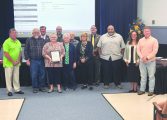By Heather Michon
Correspondent
The Board of Supervisors approved a zoning change that prohibits utility-scale projects in land zoned for agricultural use and called for the creation of a new solar district.
The vote came at the end of a lengthy public hearing, which was itself at the end of a lengthy regular meeting on Wednesday evening (July 3). Supervisors traditionally hold both July meetings in one night, giving themselves a short summer break.
The zoning change halts progress on solar projects of greater than two megawatts for the foreseeable future.
A special Solar Ordinance Review Committee, composed of Supervisors Tony O’Brien (Rivanna) and Tim Hodge (Palmyra) and Planning Commissioners Lorretta Johnson-Morgan (Columbia) and Kathleen Kilpatrick (Fork Union), has begun deliberations over new zoning rules. The process is expected to take several more weeks.
The committee’s proposals will then have to go before the Planning Commission for review and public hearing before coming before the supervisors for a final review and approval.
Many citizens shared their thoughts during a public comment period lasting around 90 minutes Wednesday night.
The arguments split into two main categories: one side argued that solar development would harm the county’s rural character and potentially cause environmental damage, and the other side argued that it could bring needed tax revenue and jobs to the area.
Supervisors struggled with these issues during their deliberations.
Initially, the only motion on the table was the removal of utility-scale solar from A-1 (Agricultural) zoning districts, where it has long been permitted under a special use permit.
The ordinance committee is in the early stages of establishing a new S-1 (Solar) district. In an S-1 district, minor- and utility-scale solar projects would be allowed, again under a special use permit.
An S-1 district could be countywide, with property owners having the option of re-zoning their A-1 land to S-1 for sale to solar developers. Or it could be restricted to certain parts of the county.
O’Brien, who has argued that heavy restrictions on solar development hurt property owners who might be looking at selling their land for solar farms, objected to removing solar from A-1 before a new regulatory plan was decided.
“I’m not okay with this board coming in and saying: we don’t have a plan, we don’t have an S-1 district, and so by right, we’re just going to deny everybody,” he said. “That is big government doing its absolute worst.”
“I disagree,” said Chair Chris Fairchild (Cunningham). “It’s us saying there’s a lot of pressures on this, and we need a pause.”
As a compromise, Hodge proposed adding language to the motion clearly stating that an S-1 district would be established.
O’Brien still declined to vote for the motion, which passed by a vote of 4-1.
FUSD FUNDING
During the first half of the meeting, the members addressed a variety of issues, including zoning waivers and public hearing advertisements.
They also approved a letter of support for a new roadside marker proposed for Columbia that would commemorate the 200th anniversary of the Marquis de Lafayette’s visit to the region.
There were also two funding requests of around $150,000 each from the Fork Union Sanitary District (FUSD).
One appropriation would fund the replacement of waterlines and valves around the decommissioned Bremo Power Plant.
The second appropriation would go to a preliminary engineering report designed to guide future system upgrades.
Supervisors approved both motions 5-0.
EMERGENCY SERVICES
As the new Department of Emergency Services has evolved, departmental supervisor Jim True requested funding and approval for organizational changes.
The proposal would upgrade his position to director of emergency services and institute a command structure of one captain and four lieutenants.
In all, the changes would require about $45,000 in funding for increases in salary and benefits.
Supervisors Mike Sheridan (Columbia) and Tim Hodge are both volunteers with county fire departments, and they approached the proposal from different perspectives.
Hodge objected to the funding request coming outside the budget season.
He also believed that “a wider discussion needed to occur” about issues like volunteer recognition, new regulations, and new positions.
“So before we go start ramping up funding and increasing money in other areas, I think we need to sit down and say, where are we in one year, five years, 10 years,” he said.
Sheridan agreed that ongoing discussions were necessary but thought that the current system was unsustainable in the near term.
“Mr. True is one 24 hours a day, seven days a week, and no human being can do that all the time,” he said.
After a long discussion, they voted 4-1 to upgrade True’s position to director of emergency services, with Hodge voting no. The motion to create the command structure passed 5-0.




